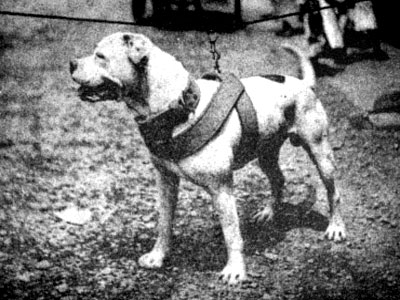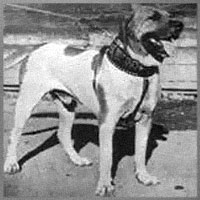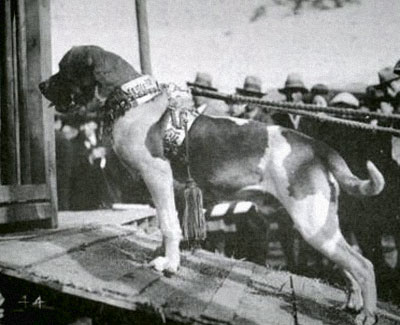Japanese Tosa

 The Tosa-Inu is believed to have been developed during the Ansei era in the Tosa region of the Shikoku Island in the Kochi prefecture of Japan by a commited fighting enthusiast who crossed the indigenous Shikoku Fighting Dog with a larger Ninoh-Inu he brought from Nagasaki, hoping to create a superior arena warrior. Unfortunately, this effort proved futile and the newly established Tosa breed was no match for the increasingly popular European fighting dogs. From then on all the way to the early years of the Showa era, a great number of Western breeds was introduced to the Tosa bloodline, such as the British and German mastiffs, bulldogges and hunting dogs, namely the English Mastiff, English Bulldog, English Bullterrier, English Pointer, Great Dane and German Pointer, as well as some St.Bernards, Bloodhounds and of course, local Akitas. Initially, the Tosa's appearance was very similar to that of Western bulldogges and bullterriers, but further crosses resulted in a larger and more massive dog of an ideal fighting temperament. While developing the Tosa Inu, Japanese dogmen also created the Shin Akita, a moderately popular fighting dog achieved by crossing the Tosa Inu with the Akita Inu.
The Tosa-Inu is believed to have been developed during the Ansei era in the Tosa region of the Shikoku Island in the Kochi prefecture of Japan by a commited fighting enthusiast who crossed the indigenous Shikoku Fighting Dog with a larger Ninoh-Inu he brought from Nagasaki, hoping to create a superior arena warrior. Unfortunately, this effort proved futile and the newly established Tosa breed was no match for the increasingly popular European fighting dogs. From then on all the way to the early years of the Showa era, a great number of Western breeds was introduced to the Tosa bloodline, such as the British and German mastiffs, bulldogges and hunting dogs, namely the English Mastiff, English Bulldog, English Bullterrier, English Pointer, Great Dane and German Pointer, as well as some St.Bernards, Bloodhounds and of course, local Akitas. Initially, the Tosa's appearance was very similar to that of Western bulldogges and bullterriers, but further crosses resulted in a larger and more massive dog of an ideal fighting temperament. While developing the Tosa Inu, Japanese dogmen also created the Shin Akita, a moderately popular fighting dog achieved by crossing the Tosa Inu with the Akita Inu.

 By selecting only the best examples and culling those found to be inferior in the fighting ring, Tosa Ken breeders were successful in establishing a reasonably consistent population of dogs, at least in terms in terms of working ability. At this point, variety of colourings were still acceptable, as well as various sizes, but with time certain bloodlines became so influential that the overall appearance was becoming more uniformed in the breed as a whole. In Japan, elaborate dog-fighting tournaments were held, not unlike those of their national sport of Sumo wrestling, with dogs even receiving Sumo champion titles for their achievements. The Japanese Mastiff was immensely popular for the way it fights, which is without sounds and often until death, the longer matches being more appreciated than the so-called "quick-kills".
By selecting only the best examples and culling those found to be inferior in the fighting ring, Tosa Ken breeders were successful in establishing a reasonably consistent population of dogs, at least in terms in terms of working ability. At this point, variety of colourings were still acceptable, as well as various sizes, but with time certain bloodlines became so influential that the overall appearance was becoming more uniformed in the breed as a whole. In Japan, elaborate dog-fighting tournaments were held, not unlike those of their national sport of Sumo wrestling, with dogs even receiving Sumo champion titles for their achievements. The Japanese Mastiff was immensely popular for the way it fights, which is without sounds and often until death, the longer matches being more appreciated than the so-called "quick-kills".

 The breed became nearly extinct during the 2nd World War, but in the following decades a joint effort between Japan, Korea and Taiwan successfully revived the Tosa, using the leftover stock and modern Western fighting dogs. The Dogue de Bordeaux has been employed in the revival effort and is believed by some to be the root of the red coats associated with the modern Tosa Inu, but the use of the French breed has been limited and was considered as a failed breeding experiment in Japan, with supposedly only one breeder championing that cross, with very little to no influence on the breed as a whole. Today it is impossible to determine the complete list of breeds which helped create and re-create the Japanese Tosa, simply because not all breeders followed the same program. There are also two Korean breeds that are closely related to the Japanese Tosa, these being the Too-Kyun Fighting Dog, often seen as basically a Korean/Taiwanese strain of the Tosa, and the very popular Korean Mee-Kyun Dosa Mastiff, which is not a fighter, but a common companion dog.
The breed became nearly extinct during the 2nd World War, but in the following decades a joint effort between Japan, Korea and Taiwan successfully revived the Tosa, using the leftover stock and modern Western fighting dogs. The Dogue de Bordeaux has been employed in the revival effort and is believed by some to be the root of the red coats associated with the modern Tosa Inu, but the use of the French breed has been limited and was considered as a failed breeding experiment in Japan, with supposedly only one breeder championing that cross, with very little to no influence on the breed as a whole. Today it is impossible to determine the complete list of breeds which helped create and re-create the Japanese Tosa, simply because not all breeders followed the same program. There are also two Korean breeds that are closely related to the Japanese Tosa, these being the Too-Kyun Fighting Dog, often seen as basically a Korean/Taiwanese strain of the Tosa, and the very popular Korean Mee-Kyun Dosa Mastiff, which is not a fighter, but a common companion dog.

 The mighty Tosa-Inu is a breed of fairly loose standards, with the Western-bred specimens being noticeably different than the ones found in Japan, in terms of size, temperament and overall appearance. Some authorities believe that American and European breeders actually still outcross their dogs, resulting in an even greater variety within the breed. This has certainly been true in the still-legal fighting world of Japan, where the American Pit Bull terrier has been used extensively to create the medium-sized Tosas for the western-style combat. Still, this is a popular Molosser today and it makes a loyal and affectionate companion, as well as a capable protection dog. Extremely dog-aggressive, the Tosa needs very broad socialization and firm, experienced handling. Some examples are very protective and unfriendly towards strangers, while others are quite docile and even-tempered. The Tosa Inu has a large head, with powerful jaws and muzzle. The neck is strong and the body is well-boned and muscular.
The mighty Tosa-Inu is a breed of fairly loose standards, with the Western-bred specimens being noticeably different than the ones found in Japan, in terms of size, temperament and overall appearance. Some authorities believe that American and European breeders actually still outcross their dogs, resulting in an even greater variety within the breed. This has certainly been true in the still-legal fighting world of Japan, where the American Pit Bull terrier has been used extensively to create the medium-sized Tosas for the western-style combat. Still, this is a popular Molosser today and it makes a loyal and affectionate companion, as well as a capable protection dog. Extremely dog-aggressive, the Tosa needs very broad socialization and firm, experienced handling. Some examples are very protective and unfriendly towards strangers, while others are quite docile and even-tempered. The Tosa Inu has a large head, with powerful jaws and muzzle. The neck is strong and the body is well-boned and muscular.
The short coat is hard and flat, coming in a few colours, the preferred ones being solid shades of fawn, red, brindle, apricot and black, with some white markings on the chest allowed. Other colours exist, like white, grey or black-n-tan and various types of tricolours, although they're not as appreciated by some breed purists. In Japan, the average height is around 24 inches, but the Western specimens can be much taller, often around 28 inches at the withers.
